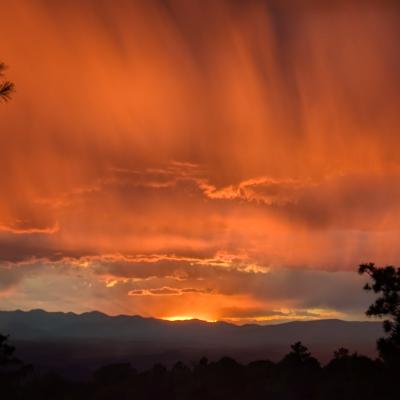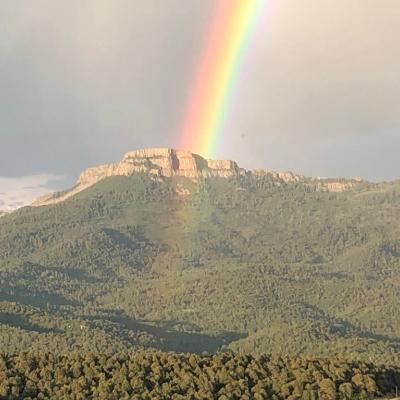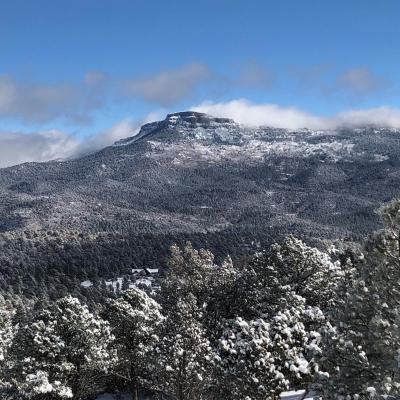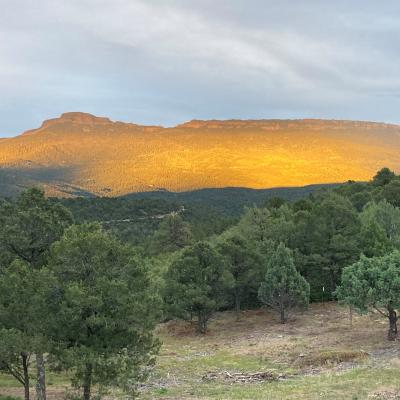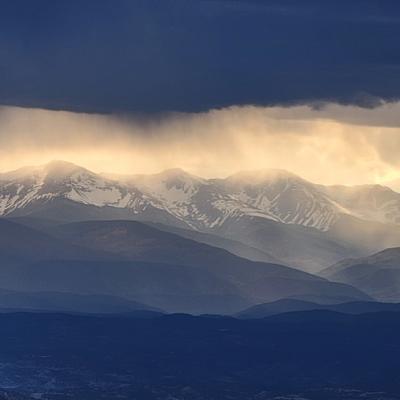History
Profiles In Ranch History - David Schroepfer
Profiles In Ranch History - David Schroepfer
In this series of articles it's been my objective not only to profile but to give recognition to those people who have contributed in a significant way to the SFTR. Some of them have made their imprint on our history in a quiet way out of the limelight and out of earshot of the mainstream. David Schroepfer is one such person.
David and his wife Shari have been SFTR property owners for the past seven years. As previous residents of Southern California, they had always had a dream to one day find a mountain top on which to live that looked out over the world. After searching all over the U.S. they found it on the SFTR but David's story begins back in New Ulm, Minnesota.
David Joseph Schroepfer was born in 1953 two months premature. Half of his siblings died in early childhood so he only knew one brother and two sisters as he grew up. David has always been the sort to journey along to his own music. He was kicked out of Catholic school because he rebelled against authority. He did much better in public school, which was less regimented and allowed a gifted spirit to develop on his own terms.
David was lucky to have a father who provided an environment conducive to his creativity. He had a wood and metal working shop in back of the family home equipped with a wealth of tools - everything a child needed to create. At the age of ten, with only a little help from his dad and brother, he rebuilt a go-cart.
At thirteen, his sister gave him an inking pen and from that moment Dave knew he wanted to design things, he says. By high school he was so proficient at mechanical drawing his drafting teacher gave him a paid job doing offset printing for school publications.
He was recruited out of high school to attend Northwest Technical Institute, a trade school which taught electro-mechanical design, which Dave describes the curriculum as half architecture and half mechanical design. It was a two year program in which he earned AA degrees in science and mechanical engineering from the mechanical design curriculum.
From there he was hired by Jeffrey Mining Company where he worked designing underground coal mining equipment. In addition, one of his first jobs was to design a long conveyor belt for Pringles potato chips.
During this period, David enjoyed building and racing motorcycles on a half mile flat track in Columbus, Ohio. He'd just completed one of his bikes in midwinter and was anxious to test drive it. He lived in an apartment building at the time and it had a long hallway indoors. So he got a buddy to help him jump start the machine and he proceeded to do a "wheelie" down the hallway, much to the entertainment of the residents and the ire of the building manager who wasn't impressed with his genius.
At age twenty-one, Dave met his first wife at a bike race. They went together for a few years then took a trip together to California so she could visit her parents. Marriage was precipitated when her parents literally tried to kidnap her away from him. Not long after this his son was born.
While visiting his folks in Minnesota with his wife and baby son, Dave saw a billboard advertising a $99 flight to California. This prompted him to decide to move there. He sent his wife and child on home to Kentucky while be bought his $99 ticket and flew to California. Almost immediately he landed a job at the San Onofre Nuclear Power Generating Station under construction. He helped design the small pipe for the turbines. Soon his wife and son joined him in California.
He decided in the early 80's that he needed some home office design experience to balance all the field experience. So he went to work for Santa Fe International. He was now designing piping systems for off-shore oil drilling vessels and platform rigs. He was also in the process of a very complex, costly and all around messy divorce. So, not being one to agonize over decisions, Dave decided to retreat to Hawaii to escape his ex-wife.
It was indeed paradise while it lasted. He lived in a house on Oahu right on the beach and he worked at Pearl Harbor as a consultant for piping systems. He had a girlfriend and soon, a baby daughter. But paradise interruptus occurred when his girl friend moved back to the mainland. Not being able to bear being separated from his little daughter by an ocean, he moved back to southern California. And back to the whole mess of his divorce which was still waiting for him. The boy was finally becoming a man.
During the Iraq/Iran war (pre-Desert Storm), Dave went back to work for Santa Fe International. They sent him to Iraq to work on Saddam Hussein's Iraq to Kuwait gas pipeline. Saddam had a whole string of gas gathering stations across the desert, but didn't have the expertise to hook them up to his pipeline so the gas could be delivered and sold. Dave designed the pipeline connections for these stations.
After he got back to southern California from Iraq, David was in dire need of some new shirts, and it was while he was shopping at Penney's that he met his wife Shari. When he found out that Shari's mom was from, of all places, New Ulm, Minnesota, he knew they'd made a cosmic connection.
By this time, Dave was "twice shy" and was convinced he wasn't anyone's prime marriage candidate. But after being together for eleven years, Shari finally convinced him to take the plunge again. On Valentine's Day in1997 at their new home on the SFTR they were wed.
Dave and Shari were fond of going up to Mt. Baldy outside of LA for picnics where they could look out over the world below. That was how they decided they would one day live on a mountain with a long view. They saw an ad in a Penny Saver in Laguna Beach where Dave was working at the time in aerospace, designing parts for the F-22 fighter plane. They talked to Ronnie Hooker at LPI and got some photos of the ranch. They knew Byron Hines through their mutual interest in motorcycles and learned he'd just bought some land on SFTR. It was May 1993 that they walked onto their land on SFTR and knew they'd found what they'd been searching for.
Shari was finishing up her masters degree and Dave was wondering how he'd make a living in the Trinidad area. Shari convinced Dave they should just get on with it, not being one to deliberate laboriously over decisions either. They built the garage first and lived in it while designing and constructing their house. Dave drew up the blue prints himself having almost no architectural experience. They contracted out the foundation, part of the framing and electrical, but did the majority of the construction themselves. All while Dave was also earning income by designing satellite space thrust systems from his garage.
The resulting endeavor is much more than just a house. It's more a multi-sensory experience, a symphony of space and form and light, a work of art. If you've never seen Dave and Shari's house, then you need to go visit them and get a tour so you'll understand my esoteric description. I promise you won't be sorry.
They were still building their house when Will Potter came to Dave to recruit him to work on the water committee. The group was trying to salvage the water system the developer had begun. The PVC pipe in units one and two had just been buried. They were talking to contractors to get the original system finished. It was in 1997 that Dave came on board, and they were leaning toward using a local contractor. But Dave and Will could see that this contractor really did not possess the capability to handle such a large scale project.
Vern Jaschke knew another contractor who used the "plowing" method of installing pipeline, and they were considering that possibility. But Vern had done only generalized drawings and they found they needed more details so they could get more accurate bids. Dave came up with a spread sheet with a complete material take off so they would have a baseline for the needed materials. They were then in a better position to more accurately compare bids and to choose the best contractor for our money.
Dave had the opportunity to attend a US West meeting in Pueblo and to meet the people who were important to our efforts to obtain phone service to the SFTR. This is where we got the significantly important information on reverse LDA's (land development agreements) where we hire the job done and US West (now Qwest) buys it back from us.
Then Dave found another local contractor to make a bid on the project. Somehow he got this person to come up with an absurdly low bid. Later when OPEC came along they decided they wanted the project badly enough and agreed to match this low bid, using top of the line materials and installation methods. The committee had the good judgment to make sure OPEC presented their bid in writing, and so they were held to this original bid.
It was a done deal - we were going to be able to upgrade the original water/phone system and complete it for only $1.49 million and we could sell the phone system back to US West at a much higher rate. Dave figures we could have ended up paying as high as $8 million for our phone system alone.
Then Will Potter, Jim Davis and Dave went to the city of Trinidad to try to get city water for the Ranch. Dave supplied the figures and mechanical details working with Vern's original drawings of the water system which were very preliminary at this stage. The city of Trinidad wasn't prepared for the high level of organization, presentation, and documentation that the committee had. Then with the formation of the metro district plus the fact that the city needed the money, things were finally settled in our favor.
What was really at work was a serendipitous collection of individuals, each with unique talents and skills, working together in ideal combination, says Dave.
There was Ted Novakowski who remembered every detail of the history of the conflicts and problems with the original water/phone system.
And they had Tom Stephens who had a genius for detail. He kept taking Vern's drawings back to him for corrections and more detail. He was the man in the field who was usually the last to check the project plans. He caught a lot of mistakes before they got built into the system.
Jim Davis had valuable experience with metro districts and was able to guide us in the process. We were able to arm ourselves, with his help, with impressive, intelligent documents so that the city was willing to take us seriously when we requested a water contract. Jim along with Will Potter had the necessary skills to schmooze the city fathers and to finally strike the deal.
Al Tucker had some good connections with some important US West (Qwest) "higher ups" that kept the ball rolling on the phone system.
And thanks to Michelle Minon and her sensible "women's perspective", the group was kept on track at times when individual differences threatened to hamper progress./p>
Dave says his contribution came mainly in the form of being able to defuse the unknowns by removing the mystique from a large utility project. He acted as a sort of intermediary between the mechanics, logistics, and planning so that no one needed to feel out of his/her element.
So by virtue of the individual personalities involved, their hard work and fearless dedication and commitment, utilizing the original plans, the original engineer, and with a lot of good luck, all things connected. The final result is a water/phone system that is far superior to what the developer's original system would have been. And we the property owners get to reap the benefits. We are getting a utility system that is worth much more than what we put into it, and in turn has made our property skyrocket in value.
-- by Carol Rawle, January 2000

